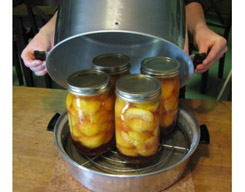
For many years, boiling water canning has been the process used to safely can foods high in acid, whether naturally acidic like fruit, jams and jellies, or acidified foods like pickles or sauerkraut. University of Wisconsin Extension has released another tested process for safely canning high-acid foods: atmospheric steam canning.
Atmospheric steam canners use steam at 212 degrees Fahrenheit to heat food in jars inside the canner to the temperature needed to make it safe. But like boiling water canning, it is only a safe method if research-tested recipes are followed exactly. University of Wisconsin Extension does not recommend relying on the canning instructions in the booklet that comes with the canner.
Certain conditions must be met in order to can safely with an atmospheric steam canner. Some of these are the same as for boiling water canning:
- Foods must be acidic, with a pH lower than 4.6
- The jars must be heated prior to filling with hot liquid, using hot or raw pack.
- Processing time must be adjusted for higher elevations. How to find elevation on Google Maps on your computer or mobile device
Specific to atmospheric steam canning, the following conditions must also be met:
- Jars must be in pure steam so the canner must be vented until a full column of steam (8-10 inches) is released from the vent ports. The internal temperature must remain at 212 degrees Fahrenheit or higher throughout the processing time. Some steam canners have a thermometer built in. For those that do not, a thermometer can be inserted into one vent port to monitor the temperature.
- Processing time, including any added for higher elevation, must not exceed a total of 45 minutes. This is because the water in the base evaporates as the process continues. Do not let the canner boil dry — this may result in an unsafe product. Never open the canner to add liquid during the process either. According to University of Wisconsin Extension, “A canner boiling too vigorously can boil dry within 20 minutes.”
Because of this time limitation on steam canning, certain foods that are acceptable to can in a boiling water canner are not to be canned in a steam canner. A good example of this is whole or halved tomatoes packed in water or without added liquid. They require 85 minutes in a boiling water canner at 1000 feet elevation or lower. This far exceeds the capability of the steam canner’s 45-minute limit. Likewise, hot-packed crushed tomatoes canned in quarts at elevations of 1001-3000 feet require 50 minutes of processing, more than is recommended in an atmospheric steam canner.
As with boiling water canning, cool jars in still, room-temperature air. This natural cooling is part of the process to insure a safe, shelf-stable canned product.
With these conditions met, recipes and procedures for boiling water canning can be safely used in a steam canner. Reliable resources for recipes include University of Missouri Extension publications or the National Center for Home Food Preservation.
For more information on atmospheric steam canning, see Safe Preserving: Using an Atmospheric Steam Canner (a University of Wisconsin Extension publication).
Go to MU Extension's Food Preservation program for more home food preservation tips.